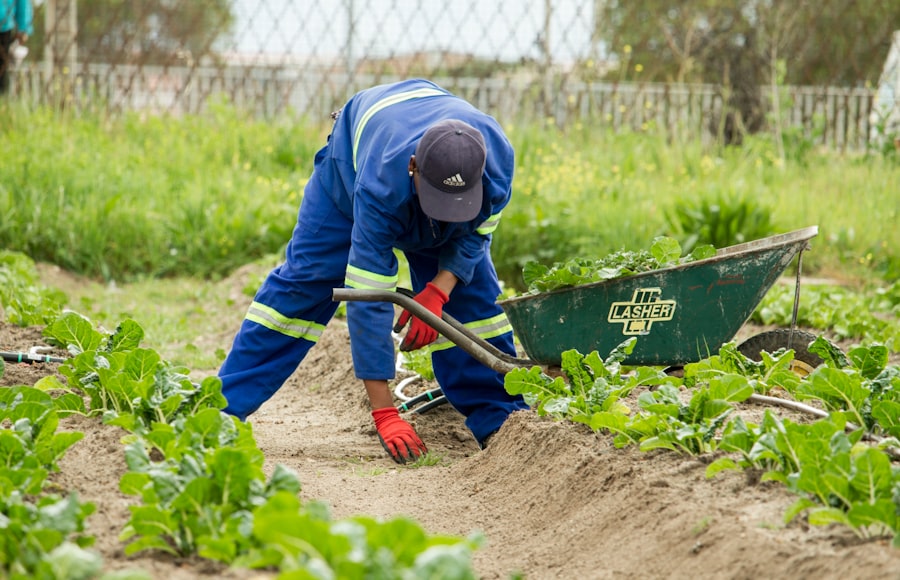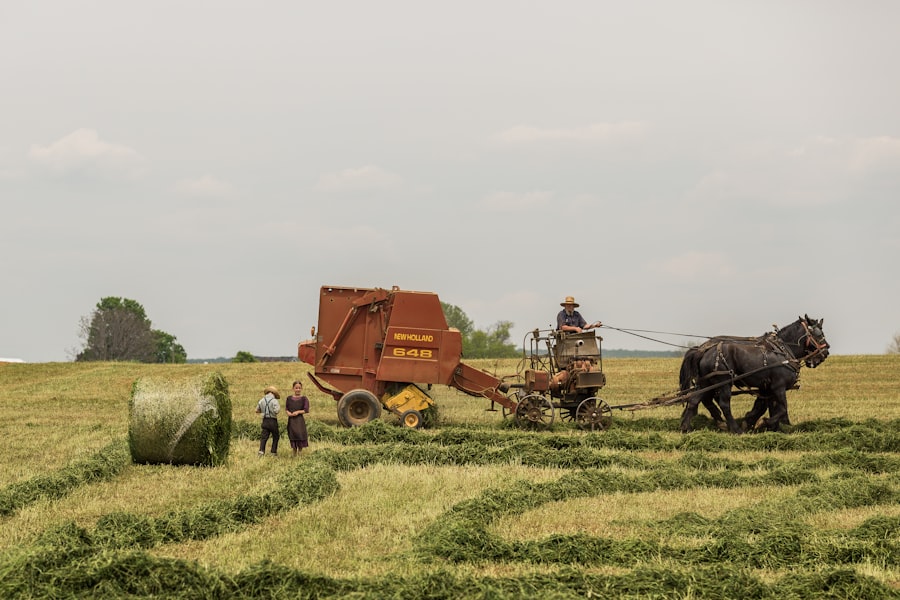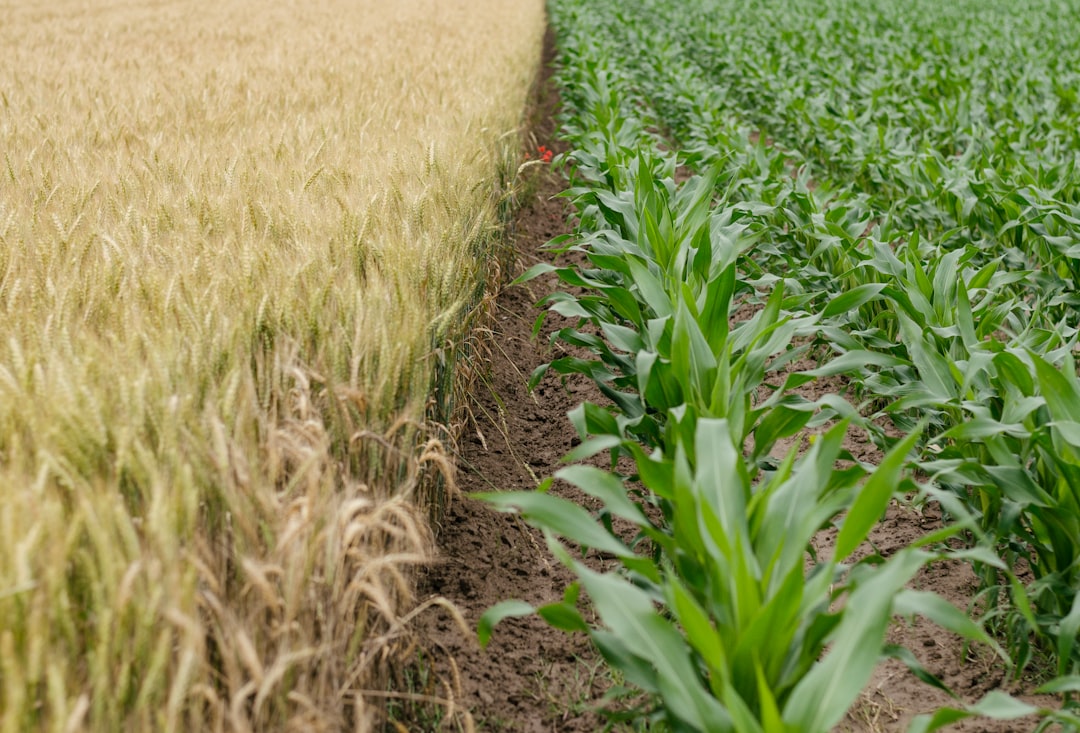Agriculture has been a cornerstone of human civilization for thousands of years, evolving from small family-run farms to the expansive corporate farming operations that dominate today’s landscape. In ancient times, agriculture was primarily a communal activity, with families cultivating small plots of land to sustain themselves. These early farmers relied on traditional methods, passing down knowledge through generations.
The focus was on subsistence farming, where families grew crops and raised livestock primarily for their own consumption. This intimate relationship with the land fostered a deep understanding of local ecosystems and sustainable practices. As societies progressed, the Industrial Revolution marked a significant turning point in agricultural practices.
The introduction of machinery and advancements in technology transformed farming from a labor-intensive endeavor into a more efficient and productive enterprise. This shift allowed for the consolidation of farms, leading to larger agricultural operations that could produce food on a grander scale. The rise of railroads and improved transportation further facilitated the distribution of agricultural products, paving the way for the emergence of agribusiness.
By the mid-20th century, corporate farming began to take root, fundamentally altering the landscape of agriculture and setting the stage for the challenges that would follow.
Key Takeaways
- The history of agriculture has evolved from small family farms to large corporate farming operations, impacting the structure and dynamics of the industry.
- The rise of corporate farming has led to the dominance of big agribusinesses, resulting in significant changes in the agricultural landscape and market dynamics.
- Corporate farming has had a profound impact on small family farms, leading to challenges such as increased competition, reduced market access, and financial strain.
- The advantages of corporate farming include economies of scale and increased efficiency, while the disadvantages include environmental concerns and reduced diversity in the agricultural sector.
- Government policies play a crucial role in supporting corporate farming through subsidies, regulations, and trade agreements, shaping the industry’s trajectory and impact on family farms.
The Rise of Corporate Farming: How Big Agribusinesses Took Over
The ascent of corporate farming can be traced back to several key developments in the agricultural sector. One of the most significant factors was the advent of biotechnology and genetically modified organisms (GMOs), which allowed for increased crop yields and resistance to pests and diseases. Large agribusinesses capitalized on these innovations, investing heavily in research and development to create hybrid seeds that could thrive in various conditions.
This technological edge enabled them to dominate the market, pushing smaller family farms to the periphery. Additionally, corporate farming benefited from economies of scale, allowing them to produce food at lower costs than their smaller counterparts. With access to vast resources, including capital, land, and advanced machinery, these corporations could operate more efficiently and profitably.
Marketing strategies also played a crucial role in their rise; large agribusinesses established strong brand identities and distribution networks that made their products ubiquitous in grocery stores across the nation. As consumer preferences shifted towards convenience and affordability, corporate farming became increasingly entrenched in the agricultural landscape.
The Impact of Corporate Farming on Small Family Farms

The rise of corporate farming has had profound implications for small family farms, many of which have struggled to compete in an environment dominated by large agribusinesses. As corporate farms expanded their operations, they often acquired land from smaller farms, leading to a significant decline in the number of family-owned agricultural operations. This trend has not only diminished the diversity of crops grown but has also eroded local economies that relied on family farms for employment and commerce.
Moreover, small family farms have faced increasing pressure to adopt industrial farming practices to remain viable. This often means investing in expensive machinery and technology that may not align with their traditional methods or values. As a result, many family farmers have found themselves caught in a cycle of debt, struggling to keep up with the demands of a market that favors large-scale production over sustainable practices.
The loss of these family farms has broader implications for food security and biodiversity, as fewer players in the market can lead to a homogenization of food sources.
The Advantages and Disadvantages of Corporate Farming
| Advantages of Corporate Farming | Disadvantages of Corporate Farming |
|---|---|
| Efficiency in production | Loss of small family farms |
| Access to advanced technology | Environmental concerns |
| Economies of scale | Monopoly power |
| Increased market power | Reduced biodiversity |
| Improved infrastructure | Job displacement |
Corporate farming presents both advantages and disadvantages that have sparked ongoing debates among policymakers, consumers, and agricultural experts. On one hand, proponents argue that large agribusinesses can produce food more efficiently and at lower costs due to their ability to leverage technology and economies of scale. This efficiency can lead to lower prices for consumers and increased food availability, which is particularly important in addressing global hunger issues.
However, the disadvantages are equally significant. The consolidation of agriculture into the hands of a few corporations raises concerns about food quality, environmental sustainability, and ethical treatment of workers. Corporate farms often prioritize profit over ecological health, leading to practices such as monocropping and excessive use of chemical fertilizers and pesticides.
These practices can degrade soil health, pollute water sources, and contribute to climate change. Additionally, the focus on mass production can compromise food quality and safety, as seen in various foodborne illness outbreaks linked to large-scale operations.
The Role of Government Policies in Supporting Corporate Farming
Government policies have played a crucial role in shaping the landscape of agriculture, often favoring corporate farming over small family farms. Subsidies for certain crops, such as corn and soybeans, have disproportionately benefited large agribusinesses that dominate these markets. These financial incentives encourage monoculture practices and contribute to the consolidation of farmland into fewer hands.
In addition to subsidies, trade policies have also impacted the competitive landscape for family farms. Free trade agreements can open markets for large agribusinesses while making it difficult for smaller farms to compete with imported goods produced at lower costs.
As a result, many family farmers find themselves at a disadvantage in an increasingly globalized economy. The challenge lies in reforming these policies to create a more equitable agricultural system that supports both corporate and family farms.
The Challenges Faced by Family Farms in the Age of Corporate Agriculture

Family farms today face numerous challenges as they navigate an agricultural landscape increasingly dominated by corporate interests. One significant hurdle is access to capital; small farmers often struggle to secure loans or financing necessary for modernizing their operations or expanding their businesses. Without adequate financial support, many family farms are unable to invest in technology or infrastructure that could enhance their productivity or sustainability.
Additionally, family farmers frequently encounter difficulties in marketing their products effectively. Unlike large agribusinesses with established brand recognition and distribution networks, small farms may lack the resources to reach consumers directly or compete on price. This disadvantage can lead to lower profit margins and reduced market share, further exacerbating their struggles.
As they grapple with these challenges, many family farmers are forced to make difficult decisions about whether to continue their operations or sell their land to larger entities.
The Importance of Sustainable Agriculture in the Battle between Corporate and Family Farms
In light of the challenges posed by corporate farming, sustainable agriculture has emerged as a vital alternative that seeks to balance productivity with environmental stewardship. Sustainable practices prioritize soil health, biodiversity, and ecological balance while still aiming to meet food production needs. Family farms often embody these principles by employing crop rotation, organic farming methods, and agroecological practices that promote resilience within local ecosystems.
The push for sustainable agriculture is not solely about preserving small family farms; it also addresses broader concerns about food security and climate change. As consumers become more aware of the environmental impact of their food choices, there is a growing demand for sustainably produced goods. This shift presents an opportunity for family farms to differentiate themselves from corporate competitors by emphasizing their commitment to ethical practices and local sourcing.
By fostering sustainable agriculture, society can work towards a more equitable food system that benefits both small farmers and consumers alike.
The Economic and Social Implications of Corporate Farming
The economic implications of corporate farming extend beyond mere production figures; they also influence rural communities and social structures. As large agribusinesses consolidate farmland and resources, local economies often suffer due to job losses and reduced spending power among residents. Small family farms typically contribute more significantly to local economies by creating jobs and supporting local businesses through purchasing supplies and services.
Socially, the rise of corporate farming has led to shifts in community dynamics as traditional farming families are displaced or forced to adapt to new realities. The loss of family farms can erode cultural heritage tied to agricultural practices passed down through generations. Furthermore, as communities become increasingly reliant on corporate entities for employment and goods, they may lose agency over their food systems and local economies.
The Future of Agriculture: Can Family Farms Survive in the Age of Corporate Agriculture?
The future of agriculture remains uncertain as family farms continue to face mounting pressures from corporate farming practices. However, there is hope for survival through innovation and adaptation. Many family farmers are exploring niche markets by producing organic or specialty crops that cater to consumer demand for quality over quantity.
By focusing on unique offerings and building direct relationships with consumers through farmers’ markets or community-supported agriculture (CSA) programs, these farmers can carve out sustainable livelihoods. Moreover, advocacy efforts aimed at reforming agricultural policies can help level the playing field for family farms. By pushing for fairer subsidies, access to resources, and support for sustainable practices, stakeholders can work towards creating an environment where both corporate and family farms can coexist harmoniously.
Ultimately, the resilience of family farms will depend on their ability to adapt while maintaining their core values rooted in community engagement and environmental stewardship.
The Role of Consumers in Supporting Family Farms
Consumers play a pivotal role in shaping the future of agriculture by making informed choices about where their food comes from. By prioritizing locally sourced products and supporting family-owned farms through direct purchases or participation in community-supported agriculture programs, consumers can help sustain these vital agricultural operations. Increased awareness about the benefits of supporting local farmers can drive demand for sustainably produced goods while fostering stronger connections between producers and consumers.
Additionally, consumer advocacy can influence policy changes that benefit family farms over corporate interests. By voicing concerns about food quality, environmental impact, and fair labor practices, consumers can hold corporations accountable while advocating for policies that support small-scale agriculture. As awareness grows about the importance of preserving family farms within the broader agricultural landscape, consumers have the power to drive meaningful change.
Finding a Balance: How to Support Both Corporate and Family Farms in Agriculture
Achieving a balance between corporate farming and family-owned operations is essential for creating a resilient agricultural system that meets diverse needs while promoting sustainability. Policymakers must consider reforms that support both sectors by providing equitable access to resources such as land grants, financial assistance programs, and technical support tailored to different scales of operation. Furthermore, collaboration between corporate agribusinesses and family farms can yield innovative solutions that benefit both parties while addressing pressing challenges such as climate change and food security.
By fostering partnerships that leverage the strengths of each sector—such as technology transfer from corporations combined with sustainable practices from family farms—agriculture can evolve into a more inclusive system that values diversity while ensuring food production remains viable for future generations. In conclusion, while corporate farming has reshaped the agricultural landscape significantly over recent decades, there remains hope for small family farms through innovation, consumer support, and policy reform aimed at creating an equitable system that values both productivity and sustainability.
In the ongoing debate between corporate farming and family farms, the dynamics of agricultural production and economic sustainability are often at the forefront. Corporate farms, with their large-scale operations and significant capital investments, are often seen as more efficient and capable of meeting the global food demand. However, family farms, which are typically smaller and often passed down through generations, play a crucial role in maintaining rural communities and preserving agricultural traditions. An insightful article that delves into the economic implications and sustainability of these two farming models can be found on How Wealth Grows.
WATCH THIS! 🫣Why Wall Street Is Buying Up America’s Farmland (And Why It Should Terrify You)
FAQs
What is corporate farming?
Corporate farming refers to the practice of large, often publicly traded, companies owning and operating agricultural businesses on a large scale. These companies may produce a wide variety of crops and livestock, and often use advanced technology and machinery to maximize efficiency and productivity.
What are family farms?
Family farms are agricultural operations that are owned and operated by a family or a small group of individuals. These farms may vary in size and scope, but they are typically smaller in scale compared to corporate farms. Family farms often prioritize sustainable and traditional farming practices.
What are the differences between corporate farming and family farms?
Corporate farming tends to be larger in scale, more mechanized, and focused on maximizing profits through efficiency and economies of scale. Family farms, on the other hand, often prioritize sustainable and traditional farming practices, and may place a greater emphasis on community and environmental stewardship.
What are the advantages of corporate farming?
Corporate farming can benefit from economies of scale, access to advanced technology and resources, and the ability to invest in research and development. This can lead to increased productivity and lower costs for consumers.
What are the advantages of family farms?
Family farms often prioritize sustainable and ethical farming practices, and may contribute to local economies and communities. They may also offer a greater diversity of products and a more personal connection to consumers.
What are the potential drawbacks of corporate farming?
Corporate farming can lead to consolidation of land and resources, potential environmental concerns, and a loss of diversity in the agricultural sector. There may also be concerns about the treatment of workers and animals in large-scale operations.
What are the potential drawbacks of family farms?
Family farms may face challenges in competing with larger corporate operations, and may have limited access to resources and technology. They may also be more vulnerable to market fluctuations and changing consumer preferences.
What is the impact of corporate farming on rural communities?
Corporate farming can lead to the consolidation of land and resources, which may have a negative impact on rural communities. This can result in fewer opportunities for small farmers, and a loss of local economic activity and community cohesion.
What is the impact of family farms on rural communities?
Family farms can contribute to the economic and social fabric of rural communities, providing employment opportunities and supporting local businesses. They may also play a role in preserving local traditions and cultural heritage.
